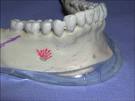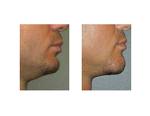Chin augmentation is a popular procedure for bringing out the prominence of the lower third of the face. It can have a powerful effect on the facial profile, particularly in men. Most commonly, the chin is brought forward in a horizontal direction elongating the jawline and improving the look of the neck angle which lies underneath.
Chin augmentation can be done by two completely different methods and is the only facial area which can be enhanced by such diametric approaches. By far, the placement of a chin implant on top of the bone makes up how it is done by most plastic surgeons. Using a variety of different implant options, the chin can be quickly and reliably brought forward in similar dimensions and shape of the implant selected. Conversely moving the chin bone, known as an osteoplastic genioplasty, can also be done to create a similar effect. Cutting the bone is technically more involved and takes longer, but in experienced hands is just as reliable as an implant.
These two chin surgery methods have their proponents and the merits of each have been debated for years in plastic surgery circles. Chin implants are usually preferred because of their ease of placement and an easier recovery. But the choice of either approach should not be based on what is easiest but what is most anatomically correct and will have the least long-term risk of complications. Each has its own place in the properly selected patient.
For small to moderate amounts of horizontal advancement, regardless of patient age, the advantages of a chin implant makes it an easy choice. Moving the chin bone for the sake of 5mms or less of movement is not worth the greater complexity of the procedure or its increased risk and costs. When the amount of chin advancement starts to get closer to 8 and 10mms, the consideration of an osteotomy starts to be a good consideration. This is particularly poignant in the younger patient in their teens and twenties. Large chin implants over a long lifetime are not without some risk of eventual problems.
What may tip the balance for an osteotomy over an implant is if there is a vertical dimension issue along with being horizontally short. While an implant can bring the chin forward, it can not obviously shorten it. Shortening a long chin can only be done by removing a wedge of bone with an advancement osteotomy. Conversely, however, an implant can lengthen a chin somewhat as it brings it forward. By positioning and securing the implant on the lowest edge of the bone, a few millimeters of vertical height can also be obtained. But more significant lengthening is best done by osteotomy where the whole chin complex and its attached soft tissue are brought down with it. This makes the vertical change in the chin more natural and physiologic.
This being said which is better, an ¦implant or osteotomy? The answer is the blending of the considerations of patient age, the dimensions of the chin deficiency, and one’s tolerance of the amount of physical recovery. Large horizontal deficiencies, vertical changes that are needed, and a young age make the osteotomy preferred over the more commonly used method of chin implant augmentation.
Barry L. Eppley, M.D., D.M.D.
Indianapolis, Indiana




